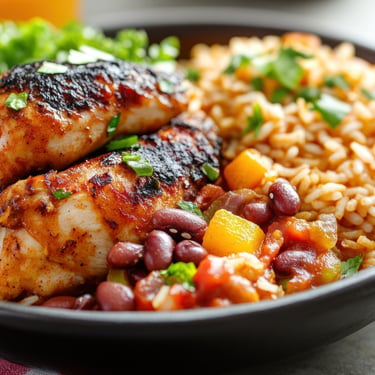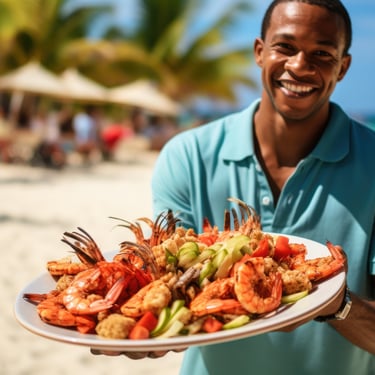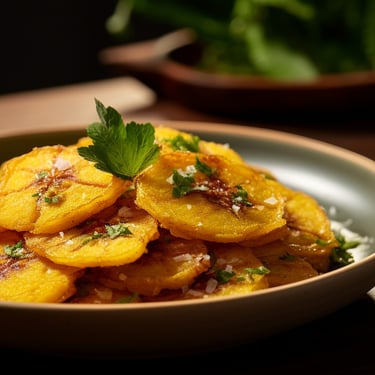DOMINICAN FOOD




Dominican food is full of flavor, using fresh local ingredients and recipes shaped by Spanish, African, and Taíno influences. Rice, plantains, coconut, and yuca are used in many meals, from sancocho and mangú to street snacks like empanadas and tostones. This guide covers what to eat, what to drink, and the best restaurants in Punta Cana, Santo Domingo, Puerto Plata, La Romana, and other popular places around the island, plus helpful FAQs for travelers. Book a food tour and experience the real flavors of the Dominican Republic.
Table of Contents
✅WHAT TO EAT
Here are some of the most loved Dominican dishes you’ll find across the country.
1. Traditional Dishes
Sancocho
A rich stew made with a variety of meats (often seven types), root vegetables, and plantains. It's considered the national dish and is typically reserved for special occasions.
Mangú
Mashed green plantains, usually served with sautéed red onions and accompanied by fried cheese, salami, and eggs—a combination known as "Los Tres Golpes." This is a staple breakfast in the Dominican Republic.
La Bandera Dominicana
Translating to "The Dominican Flag," this meal consists of white rice, stewed beans, and meat (commonly chicken or beef), often served with a salad and fried plantains.
Tostones
Twice-fried green plantain slices, commonly served as a side dish or snack.
Mofongo
A dish made from fried green plantains mashed with garlic and chicharrón (pork cracklings), often shaped into a ball and served with a savory broth.
Chimichurri Burger (Chimi)
A Dominican street food staple, the chimi is a burger made from seasoned ground pork or beef, topped with cabbage and a tangy sauce, all nestled within a soft roll. It's especially popular in urban areas during the evening.
2. Traditional Snacks
Yaniqueques
Popular especially in beach areas like Boca Chica, yaniqueques are deep-fried dough discs that are crispy and savory, making them a favorite seaside snack.
Empanadas (Pastelitos)
These are pastry turnovers filled with various ingredients such as beef, chicken, cheese, or vegetables. They are deep-fried to a golden brown and are commonly found at street vendors and gatherings.
Quipe (Kipe)
A Dominican adaptation of the Middle Eastern kibbeh, quipe consists of bulgur wheat mixed with minced beef and spices, then deep-fried. It's a popular appetizer and street food item.
3. Must-Try Desserts
Dulce de Leche
Made by slowly cooking sweetened milk until it thickens and turns golden, this smooth caramel is a popular ingredient in Dominican desserts. Locals use it in cakes, flan, or simply spread it on toast for a sweet snack.
Habichuelas con Dulce
A smooth, sweet blend of red beans, coconut milk, cinnamon, and cloves, this dessert is a Dominican classic. It’s most popular during Semana Santa or Easter Week, when families prepare big batches to share. Many people also enjoy it year-round, usually served warm with crunchy biscuits on the side.
Arepa Dominicana
This traditional cornmeal cake is dense, sweet, and flavored with coconut milk, raisins, and cinnamon. It’s often baked slowly until golden and is a popular treat to enjoy with a cup of strong Dominican coffee.
Flan
This smooth custard is baked with a layer of caramel and usually made with evaporated and condensed milk. Some versions include coconut or citrus zest for a local twist. It’s a favorite at family meals, in restaurants, and during special celebrations.
Majarete
A soft corn pudding made with fresh corn, coconut milk, and vanilla, then topped with cinnamon. It’s a simple homemade dessert that’s often served cold and enjoyed with family.
Bíñuelos
These golden yuca dough balls are fried until crispy and then soaked in sweet spiced syrup. With a soft center and slightly crunchy outside, they’re a rich dessert often enjoyed during Christmas or Easter.
Dulce de Coco
A sticky-sweet coconut treat cooked with sugar and spices, often shaped into bars, balls, or cookies, perfect for snacking.
Helado de Batata
Sweet potato ice cream blended with coconut milk, cinnamon, and nutmeg. Creamy, refreshing, and unforgettable.
Jalao
Small coconut and honey balls with a chewy texture and rich flavor. Jalao is a traditional sweet often sold at roadside stands as a quick local treat.
Polvorones
Crumbly sugar cookies with a buttery texture and a light touch of vanilla. They’re a popular snack, especially with a cup of coffee or hot chocolate.
If you want to bring the flavors of Dominican cooking into your home, The Dominican Kitchen by Vanessa Mota is a great place to start. It features 80 easy and authentic recipes, including chulitos, chimi burgers, plátanos fritos, and more traditional favorites inspired by Dominican culture and everyday home cooking.
✅WHAT TO DRINK
From fresh juices to local favorites, these are some of the most popular drinks to try in the Dominican Republic.
Morir Soñando
A refreshing and creamy drink made with fresh orange juice, milk, sugar, and ice. It tastes like a melted creamsicle and is perfect for hot days. The name means "to die dreaming," and after one sip, you'll understand why!
Fresh Tropical Juices
The Dominican Republic is full of fresh tropical fruits, and their juices (jugos naturales) are a must-try. Many vendors blend these into smoothies (batidas) by adding milk for a richer taste. Read more
Mamajuana
A legendary drink made from rum, red wine, honey, and herbs soaked in tree bark. It's said to have medicinal benefits, including boosting energy. You can buy it pre-made or get a bottle with dry ingredients to mix at home. Either way, it makes a great souvenir! Learn more
Dominican Hot Chocolate
The Dominican Republic is one of the world’s top cacao producers. Their chocolate caliente (hot chocolate) is made with locally grown cacao, cinnamon, and nutmeg. Unlike sugary store-bought cocoa, this version is rich, aromatic, and full of deep chocolate flavor.
Want to learn more about Dominican cacao? Read this blog post and book a cacao tour to see the process from bean to bar!
Jugo de Avena
A smooth and nutritious drink made from blended oats, milk, cinnamon, and sugar. It’s usually served cold and is a favorite for breakfast.
Mabí
A tangy, slightly fizzy drink made from the bark of the bejuco indio vine. It’s common in small shops and rural areas. Some versions are non-alcoholic, while others have a mild kick from natural fermentation.
Guarapo de Piña
Made by fermenting pineapple peels with sugar and water, this naturally fizzy drink is refreshing and slightly alcoholic. A great eco-friendly way to use the whole fruit!
Dominican Coffee
Dominican coffee is rich, full-bodied, and usually served as a strong espresso-like shot called café Santo Domingo. Locals often drink it black with sugar, but adding milk is also common. Be sure to try it at a café or buy a bag to take home. Read more
Presidente Beer
The most popular beer in the country, Presidente is a crisp, light lager best enjoyed ice-cold. It’s often served in large bottles called jumbos. Other local beers to try include Bohemia or Canita, the beer of Punta Cana
Dominican Rum
Rum is a big part of Dominican culture, and the country produces some of the finest aged rums in the world. You can enjoy Dominican rum straight, in a cocktail like Cuba Libre (rum and cola), or in a refreshing piña colada. Experience Rum firsthand and book a rum tasting tour in Punta Cana
✅RESTAURANTS
Discover the Dominican Republic’s dining scene, from seaside fine-dining to cozy local restaurants in Santo Domingo, Punta Cana, Puerto Plata, and La Romana.
1. Santo Domingo
Adrian Tropical
A favorite among locals and tourists, Adrian Tropical serves authentic Dominican dishes like mofongo and sancocho. Its waterfront location provides a scenic dining experience.El Mesón de la Cava
Nestled within a natural limestone cave, this unique restaurant offers a memorable ambiance alongside a menu featuring both local and international dishes.El Conuco
Immerse yourself in Dominican culture at El Conuco, known for its traditional cuisine and lively atmosphere, complete with music and dance performances.
2. Punta Cana
La Yola
Designed by Oscar de la Renta, La Yola is built on stilts over the Caribbean Sea, providing stunning views and a menu that blends Mediterranean and Caribbean flavors.Onno's Punta Cana
A lively spot known for its vibrant atmosphere, Onno's offers a mix of local and international dishes, along with a variety of cocktails, making it a popular hangout.Noah Restaurant & Lounge
With a chic and modern vibe, Noah blends global flavors with Dominican flair. From fresh seafood to gourmet burgers, each dish is beautifully presented, making it a top choice for stylish dinners or casual lunches in Punta Cana.Citrus Fusion Cuisine
Citrus brings together Caribbean, Asian, and Italian influences in one cozy, laid-back location. Known for its sushi, ceviche, and Angus steaks, it's a versatile spot perfect for family meals or romantic evenings in Bávaro.La Bruja Chupadora
This steakhouse-meets-party-hub is a Bávaro favorite for grilled meats and good times. With live music on weekends and a name that translates to "The Sucking Witch," it’s a quirky, fun place to unwind with friends and a cold Presidente.TOC Beach Bar & Restaurant
Located right on the sand in Playa Turquesa, TOC pairs Dominican comfort food with ocean views. The vibe is chill, the cocktails are refreshing, and the beachy playlist makes you want to stay for hours.
3. Puerto Plata
Casita Azul Restaurante
Set in a charming blue house, Casita Azul is known for its cozy atmosphere and a menu that highlights fresh seafood and local ingredients.La Isabela Colonial Restaurant
Offering a blend of colonial charm and modern cuisine, this restaurant provides a unique dining experience in the heart of Puerto Plata.
4. La Romana
Marinelly’s Restaurant is celebrated for its authentic Dominican cuisine and warm hospitality. Diners often praise the flavorful dishes and the welcoming atmosphere, making it a must-visit spot for those seeking a genuine local dining experience.
Tipico Bonao offers a vibrant setting to enjoy traditional Dominican dishes. Known for its delicious food and lively atmosphere, it's a culinary gem that provides an authentic taste of the island's rich culinary heritage.
Set by the waterfront, Restaurante La Casita offers a pleasant ambiance with ocean and yacht views. The menu features dishes like churrasco and seafood paella, providing a delightful dining experience in La Romana.
Best Ways to Book a Restaurant
Online Platforms: Utilize platforms like OpenTable to view menus, check availability, and make reservations.
Direct Contact: Calling the restaurant directly can sometimes secure a reservation, especially for larger groups or special occasions.
Hotel Concierge: If you're staying at a hotel, the concierge can often assist with recommendations and reservations, leveraging their local connections.
Dining Times: Dominicans typically dine later in the evening, with dinner often starting around 8 PM. Planning accordingly can enhance your dining experience.


✅Frequently Asked Questions
How do you say "Enjoy your meal" in the Dominican Republic?
The common phrase is “¡Buen provecho!”, a friendly way to wish someone a good meal in the Dominican Republic.
How much does food cost in the Dominican Republic?
Food prices vary depending on the type of establishment:
Local Comedores: These are small, family-run eateries offering traditional Dominican meals. A "plato del día" (plate of the day) typically includes rice, beans, meat, and salad, costing between $3 to $5 USD.
Mid-Range Restaurants: Dining at more upscale establishments can cost between $15 to $50 USD per person, depending on the menu and location.
Street Food: Options like empanadas or tostones are affordable, usually costing around $1 to $2 USD per item.
Overall, dining in the Dominican Republic can be quite economical, especially when enjoying local cuisine.
Is street food safe to eat in the Dominican Republic?
Street food is an integral part of Dominican culture and can be safe to eat if you choose vendors carefully:
Select Busy Vendors: High customer turnover often indicates fresh food.
Observe Hygiene Practices: Ensure the vendor maintains cleanliness in food preparation and handling.
Opt for Cooked Items: Foods cooked thoroughly and served hot are generally safer choices.
Taking these precautions allows you to enjoy the rich flavors of Dominican street food safely.
Are vegetarian or vegan options available in Dominican cuisine?
While traditional Dominican cuisine is meat-centric, there are options for vegetarians and vegans:
Vegetarian Dishes: Dishes like tostones (fried plantains), yuca (cassava), and rice with beans can be suitable.
Vegan Adaptations: Communicate your dietary preferences clearly; many establishments can modify dishes to exclude animal products.
In larger cities and tourist areas, you'll find restaurants with dedicated vegetarian and vegan menus.
Are there any unique dining customs I should be aware of?
Yes, here are some Dominican dining customs:
Hospitality: Dominicans are known for their hospitality and generosity; it's common to be offered food when visiting someone's home.
Sharing: Meals are often communal, emphasizing sharing and socializing.
Island Time: There's a relaxed approach to time; don't be surprised if meals start later than scheduled.
How can I best experience Dominican cuisine at an all-inclusive resort?
All-inclusive resorts in the Dominican Republic offer a variety of dining options, including buffets and à la carte restaurants. To fully immerse yourself in Dominican culinary delights:
Explore Local Dishes: Seek out restaurants within the resort that specialize in Dominican cuisine.
Attend Themed Nights: Many resorts host themed dining events featuring local specialties. Participating in these can provide an authentic taste of the region's flavors.
Engage with Chefs: Don't hesitate to ask the culinary staff about the dishes and their preparation. They can offer insights and recommendations to enhance your dining experience.
Venture Off-Resort: Consider dining at local restaurants outside the resort to experience traditional Dominican food in its native setting. This allows for a broader culinary exploration and supports local businesses.
✅FOOD TOURS
Book a food tour today and experience the best of Dominican flavor with a local guide.
Ready to taste the flavors of the Caribbean? Book your flight to the Dominican Republic now and start your foodie adventure!
Terms and Conditions © All rights reserved 2025
Affiliate Disclaimer
Some links on DR Simplified are affiliate links. If you make a purchase or booking, we may earn a commission at no extra cost to you. Thanks for your support!
